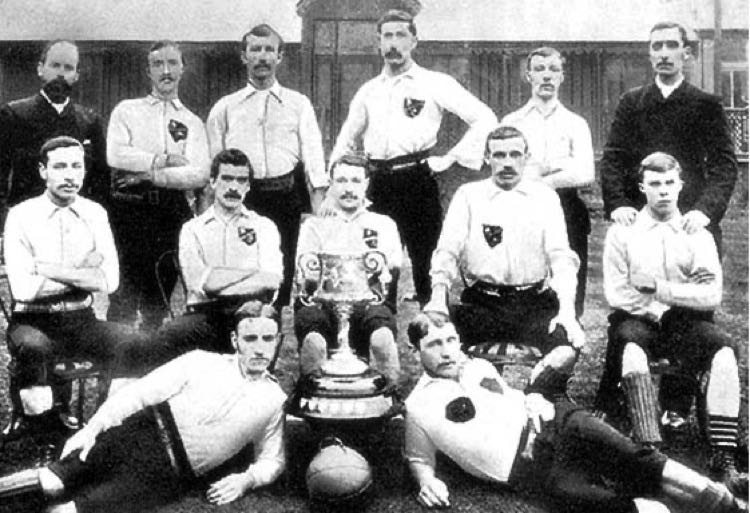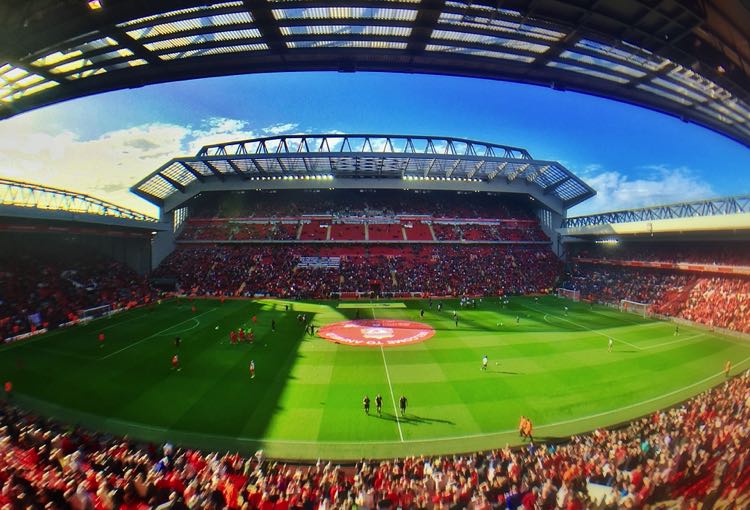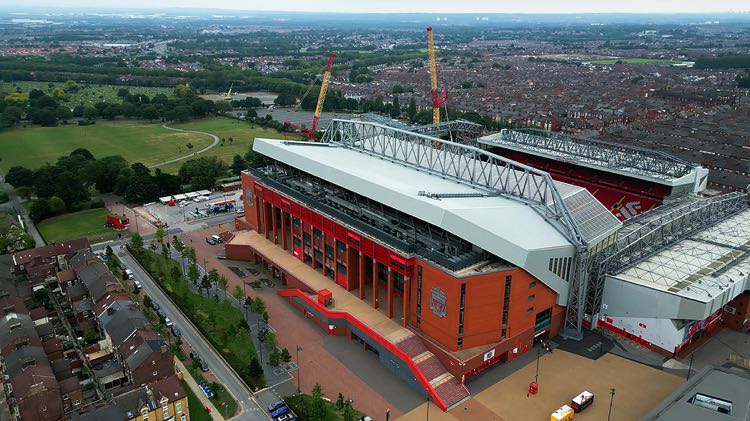Anfield Stadium has been the home of Liverpool FC since the club was founded way back in 1892 and is one of world football’s most iconic football grounds. Anfield seats 53,394 spectators, and is packed week in and week out with adoring Reds fans. They have certainly enjoyed their fair share of footballing glory on Merseyside. From the golden eras of Shankly and Paisley to the successes of “King” Kenny Dalglish, to the more recent achievements of Jürgen Klopp, some fantastic coaches have occupied Anfield’s famous dugout, whilst some of the greatest players in history have made its hallowed turf their home.
You might be surprised to learn, however, that the historic stadium was actually originally home to Liverpool’s Merseyside rivals, Everton – something we will explain in more detail in this article. We will also be taking a look at when the ground was built, as well as rounding up any redevelopments that it has undergone throughout its long history.
When Was Anfield Built?
Before we dive into the ground’s construction, it is worth first just highlighting where the name “Anfield” comes from. The stadium is named after the suburb in which it is situated (which is, of course, is Anfield), and the name itself supposedly derives from the Old English word for a “field on a slope.”
Anfield (the stadium) was built in 1884 under the instruction of John Orell, a local landowner, for his friend, John Houlding. It was originally rented by Everton, who had been forced to find a new stadium. This was because their ground at the time, a tiny stadium in Priory Road, was deemed too noisy, as the Toffees were quickly gaining a widespread following across Liverpool. Houlding was the President of Everton and a local council member, and it was under his leadership that the club became a proper footballing outfit and an inaugural member of the Football League, rather than an amateur team. The first game ever played at Anfield was between Everton and Earlestown in September 1884, and saw the Toffees win 5-0. So, why did Everton end up leaving Anfield?
Everton Leave Anfield for Pastures New

Although the club’s tenure at Anfield was a success on the football pitch, with Everton actually winning the First Division title in 1890/91, the ground quickly became unpopular with many of the club’s board, largely thanks to John Houlding. This was because, not only was the rent he charged deemed overly pricey, but Houlding, who was a brewer by trade, decided that only his ales would be sold at Anfield, a decision that was hugely lucrative for him.
Furthermore, the President’s choice to have the team use the local “Sandon” pub as the dressing room was also proving unpopular, as the Everton players, who had just won the title, were having to squeeze past pub punters on match day. You can hazard a guess at what beer they happened to have on tap in the Sandon, as well! When the Toffees first played at Anfield, Houlding charged £100 rent, and by 1890, this had increased to £250. A crisis was brewing…
The Birth of Liverpool FC
As the tension increased, Houlding decided to chair a meeting with the club’s board, where he suggested that they should purchase Anfield outright, but this proposal was rejected, as they deemed the price was too high. This meeting led to most of the Everton board and playing squad deciding to build a new, separate ground, and officially part ways with Houlding, who then decided to set up a new club to play at the now-empty Anfield Stadium.
This club, created by Houlding and several of his friends from Everton, including former club secretary, William Barclay, became Liverpool FC, who played in red, rather than blue. Liverpool were built from the ground up and were initially rejected from the Football League, meaning that the Reds’ first season saw them compete in the local Lancashire League. The Merseyside club’s first game at Anfield was a friendly against Rotherham, and they announced their entrance into English football with a destructive 7-1 victory. A sign of things to come?
Expanding Anfield

Although Anfield was capable of holding some 20,000 spectators and had drawn large crowds when occupied by Everton, the newly formed Liverpool struggled to attract a significant number of fans to attend their matches. The club’s first game against Rotherham was only watched by 200 people!
However, by the time the Reds were able to enter the Football League for the 1983/84 campaign, they had garnered a decent local following, with 5,000 spectators turning up to their first league game against Lincoln City. The club then began expanding Anfield, with a new Main Stand built in 1895 to hold a further 3,000 supporters. More new stands were built in 1904 and 1906, with the latter becoming known as the Spion Kop, which remains the stadium’s most iconic stand, named after a hill in South Africa where a British regiment sustained heavy losses during the Boer War, with many of those killed hailing from Liverpool.
It was not until 1928 that Anfield began to reflect the club’s stature and passionate fanbase when the Kop was expanded to hold some 30,000 standing fans by itself. This made it the largest stand in the country and it could hold more fans than some entire grounds!
Advancements & All-Seater Stadium
Floodlights were then added in 1957, costing around £12,000, and were first switched on during a game against local rivals Everton. More developments followed as the Main Stand was partly demolished in 1973 and extended; the ground had, up to this point, almost continually increased in capacity over the years. Despite this, the ground’s record attendance was actually set back in 1952, when nearly 62,000 fans flocked to Anfield to watch the Reds take on Wolves.
However, the Hillsborough Disaster on 15th April 1989, in which 97 Liverpool fans sadly lost their lives, led to the publication of the Taylor Report, which declared that football grounds should be converted to all-seater stadiums. Anfield, therefore, had to be transformed. This redevelopment saw the Kop now reduced to just 12,390 spectators, rather than a capacity of 30,000, although this was made up for by the vast expansion carried out on the Kemlyn Road stand in 1992.
Plans to expand the stand had been in place since the 1970s, but had to be delayed after Nora and Joan Mason, two sisters who had been living where the stand was planned to be constructed, refused to sell their house! Since then, the ground has been continually redeveloped throughout the Premier League era, with statues of legendary managers, Bill Shankly and Bob Paisley, also being installed outside. The Kemlyn Road stand was also renamed the Sir Kenny Dalglish stand.
Is Anfield Still Being Developed?

The short answer here is: yes. After plans to move the club to a new 61,000-capacity stadium in nearby Stanley Park fell through following the financial crisis of 2008, owners, Fenway Sports Group, decided instead to expand Anfield. The first stage of this expansion was completed in 2016 after the Main Stand was expanded to hold a further 8,500 supporters.
This was enabled after the club purchased a number of houses in the local area to allow sufficient space for construction. The second phase of the historic stadium’s redevelopment is due to be completed in 2023, having begun in 2021. This expansion centres on the Anfield Road stand, which will be enlarged to seat another 7,000 fans, costing a reported £60 million and increasing the ground’s total capacity to an impressive 61,000.

